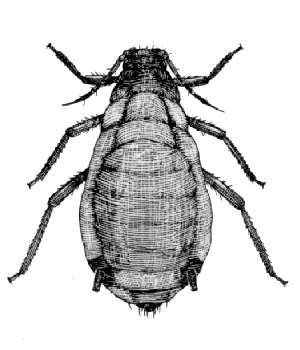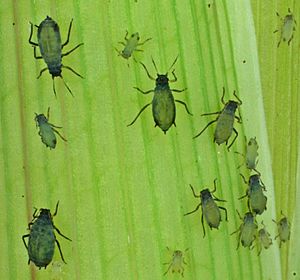Rhopalosiphum maidis facts for kids
Quick facts for kids Rhopalosiphum maidis |
|
|---|---|
 |
|
| Scientific classification | |
| Synonyms | |
|
The corn leaf aphid, also known as the corn aphid, is a tiny insect called Rhopalosiphum maidis. It's a common pest that causes problems for maize (corn) and other crops. You can find these aphids almost everywhere in the world, especially in farm fields, grassy areas, and places where forests meet grasslands.
Among all the aphids that feed on corn, the corn leaf aphid is the most common and causes the most damage, especially in warm, tropical places. Besides corn, it can also harm rice, sorghum, and other cultivated and wild plants that are monocots (plants with one seed leaf).
Contents
What Does It Look Like?
Wingless female corn leaf aphids, which reproduce without a mate, are green or whitish-green. Their head, antennae, legs, cornicles (small tubes on their back), tail, and the bands across their body are black-brown. They have a few short hairs on their body.
Their antennae are less than half the length of their body. The cornicles are not longer than their finger-like tail. Winged females have a black-brown head and chest area. Their cornicles are shorter than those of the wingless females.
Most corn leaf aphid groups reproduce only by parthenogenesis (without mating). This means the females produce offspring all by themselves. However, scientists have seen sexual reproduction (with males and females) in Pakistan and Korea. In these cases, Prunus trees (like cherry or plum) are their main host plants. In Japan and Kenya, males have been found, but not sexually reproducing females.
How They Affect Crops
In winter, winged female aphids and young aphids survive on wild monocots. When spring arrives, they fly to farm fields. The aphids slowly spread from the edges of the field to the middle. They reproduce very quickly, sometimes having up to twelve generations in one year! The number of aphids is usually highest in late summer.
When there are many corn leaf aphids on corn plants (Zea mays), they can directly harm the plants by sucking out important nutrients. They also leave behind a sticky substance called honeydew on the corn tassels (the top part of the corn plant). This honeydew can stop the pollen from falling, which means the corn won't grow as well. This can reduce the corn harvest by as much as 90%.
The corn leaf aphid can also spread several harmful viruses to corn plants. These include Maize yellow dwarf virus, Barley yellow dwarf virus, Sugarcane mosaic virus, and Cucumber mosaic virus.
Besides corn, these aphids also feed on many other cultivated grasses. These include wheat, barley, oat, rye, sorghum, sugarcane, and rice. Barley is a very good host plant for the corn leaf aphid. However, different types of barley can have different levels of resistance to the aphids.
How Plants Fight Back
Scientists have found that when barley plants grow in air with more carbon dioxide (CO2), the corn leaf aphids on them grow and reproduce much slower. The smells coming from these barley plants are also less attractive to the aphids. Temperature and how crowded the aphids are can also change whether they grow wings when they reproduce without mating.
Different types of corn plants have different levels of natural resistance to corn leaf aphids and other insect pests. Corn plants have natural defenses, like special chemicals. Some of these chemicals can make it harder for aphids to feed. For example, some corn plants produce more of a chemical called DIMBOA-Glc, which helps them resist the aphids.
When corn plants are damaged, they release certain smells. In experiments, corn leaf aphids were pushed away by the smells from damaged corn plants. One of the main smells released by damaged corn is a chemical called (E)‐β‐farnesene. This chemical also acts as an alarm signal for aphids, so it might scare them away.
Studying Their Genes
The corn leaf aphid can have different numbers of chromosomes (the parts of cells that carry genes). Some have 8, some 9, and some 10. Aphids found on corn plants usually have 8 chromosomes, while those on barley plants often have 10.
Scientists have studied the genes of a corn leaf aphid that reproduces without mating. This helps them learn more about how the aphids interact with their environment, how they spread viruses, and how they become resistant to pesticides. The study found that the aphid's genetic material is about 321 million units long and has 17,629 genes that make proteins.
Host Plants
The corn leaf aphid feeds on many different plants, including:
See also
 In Spanish: Rhopalosiphum maidis para niños
In Spanish: Rhopalosiphum maidis para niños


